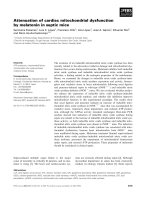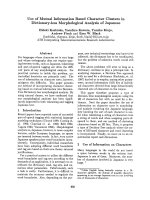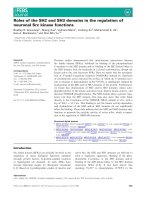Báo cáo khoa học: "Isolation of Subgroup J Avian Leukosis Virus in Korea" potx
Bạn đang xem bản rút gọn của tài liệu. Xem và tải ngay bản đầy đủ của tài liệu tại đây (67.46 KB, 4 trang )
J O U R N A L O F
Veterinary
Science
J. Vet. Sci. (2002), 3(2), 71-74
ABSTRACT
3)
Tw o subgroup J avian leukosis viurses (ALVs) w ere
isolated from broiler breeder flocks, in w hich myeloid
leukosis had occurred. The isolates could be classified
as subgroup J ALV by the positive reaction in polymerase
chain reaction (PCR) with primers specific for subgroup
J ALV. Tw o isolates replicated in chicken embryo
fibroblast (CEF) cells from the alv6 chicke n line in
w hich cells are resistant to subgroup A and E ALVs.
In
in vitro
serum neutralization tests w ith other
subgroup ALVs including ADOL-Hc1, the prototype of
subgroup J ALVs isolated in the United States of
America, tw o isolates w ere partially neutralized by
antibody to ADOL-Hc1, indicating that Korean isolates
and ADOL-Hc1 m ay be antigenically related, but not
identical. When the P CR w as done with a primer pair
designed to amplify genes of E element and long
terminal repeat of proviral DNA, the PCR product
size of one isolate (KOAL-PET) w as sm aller than that
of ADOL-Hc1, suggesting that some sequences in
these regions are deleted.
Key w ords :
subgroup J avian leukosis virus, myeloid
leukosis, virus isolation
Introduction
Avian leukosis is a neoplastic disease caused by avian
leukosis viruses (ALVs). ALVs from chickens have been
divided into six subgroups (A, B, C, D, E and J) on the basis
of their host range, viral envelope interference and
cross-neutralization patterns (10). Subgroups A, B, C, and D
are exogenous viruses capable of inducing tumors, and
subgroup E viruses are endogenous viruses of low
pathogenicity. Subgroup J viruses, which have been isolated
recently from broiler chickens, are recombinant between
*
Corresponding author:
Tel: +82-31-467-1810, Fax: +82-31-467-1814
E-mail:
exogenous and endogenous viruses (2,3,4,17). Although
ALVs can induce various types of tumors, lymphoid leukosis
is the most common in chickens. However, subgroup J
viruses, first reported in the United Kingdom in 1991,
induce primarily myeloid leukosis (11,12). Subgroup J
viruses have a broad host range and all lines of chickens
tested are susceptible to infection (14). The nucleotide
sequence of subgroup J viruses showed multiple changes in
env gene among the isolates and antigenic variants of the
viruses were found in subgroup J viruses (18).
The isolation of subgroup J virus was not reported in
Korea. Myeloid leukosis has increased recently in broiler
breeder flocks in Korea. This study describes the isolation of
subgroup J ALVs from broiler chickens in Korea.
Materials and Methods
Viruses and antibodies.
The prototypes of ALV subgroup A, E, and J were
Rous-associated virus (RAV)-1, RAV-0, and ADOL-Hc1,
respectively, and were maintained at Avian Disease and
Oncology Laboratory (ADOL) in USA. The polyclonal
antibodies against ALV were also from ADOL.
Cells for virus isolation.
Cells for virus isolation or virologic assays were C/E
(resistant to infection with endogenous ALV) line 0 CEF,
C/AE (resistant to infection with subgroup A and E ALV)
alv6 CEF and C/O (susceptible to all ALVs) 15B1 CEF (6,7).
The presence of ALV in infected cells was confirmed by
enzyme-linked immunosorbent assay as reported (15).
Serum neutralization test.
Antigenic relationship of isolates to other subgroups of
ALV was determined by cross-neutralization test as
described (9). Briefly, one fifth diluted sera were mixed with
each viruses which titers were adjusted to 500-1000
infectious units/ml and incubated at 37
℃
for 45 minutes.
The neutralized samples were then inoculated on line 0
CEF cells and incubated for 7 days. The group-specific
antigen was detected from the cell lysates by ELISA.
Isolation of Subgroup J Avian Leukosis Virus in Korea
Haan-Woo Sung*, Jae-Hong Kim, Sanjay Reddy1 and Aly Fadly1
National Veterinary Research and Quarantine Service, Ministry of Agriculture & Forestry, 480 Anyang 6-Dong,
Anyang 430-016, Korea
1U.S. Department of Agriculture, Agricultural Research Service, Avian Disease and Oncology Laboratory,
3606 East Mount Hope Road, East Lansing, MI 48823
Received Feb. 1, 2002 / Accepted Apr. 25, 2002
72 Haan-Woo Sung, Jae-Hong Kim, Sanjay Reddy and Aly Fadly
Table 1.
Korean ALV isolates from meat type chickens.
Isolate
Age
(weeks)
Type of flocks
Organs virus
isolated
Year
KOAL-PET 50
grandparent
stocks
Liver 1997
KOAL-HD 25 parent stocks Liver 1998
Table 2.
ALV group-specific antigen positive rate of
flocks which ALVs were isolated.
Flocks Weeks Samples Positive rates (%)
PET1
50
Serum 4/24 (16.7)
Egg albumen 5/30 (16.7)
HD2
25 Serum 25/74 (33.8)
1 KOAL-PET was isolated from this flock
2 KOAL-HD was isolated from this flock
Polymerase chain reaction (PCR).
PCR was done for the detection of proviral DNA from
cells infected with isolates. DNA was prepared with the
Qiagen DNA isolation kit (Qiagen Inc., USA) and about 10
0
~
150ng of genomic DNA was used for PCR of 25ul volume.
Primer pair S1/S2 (S1; 5'-AATTCTGCTTGAAATATG-3', S2;
5'-AGTTGTCAGGGAATCGAC-3') was derived from the
unusual E element and the long terminal repeat of proviral
ALV, and PCR was specific for subgroup J ALV or some
Rous sarcoma viruses as described (16). The cycling conditions
of PCR were denaturation at 94
℃
for 4 min, followed by 30
cycles at 92
℃
for 1min, 48
℃
for 1min, and 72
℃
for 1min.
A final extension was conducted at 72
℃
for 5min. PCR
products were resolved in 1.5% agarose gel with electro-
phoresis in tris-acetate-EDTA buffer for 30 min at 95 volts.
ALV antigen test from flocks.
Samples of plasma or egg albumen from flocks in which
ALVs were isolated, were tested for ALV group-specific
antigen by ELISA with ELISA kit (KPL, USA).
Results
Virus isolation.
Two ALVs, KOAL-PET and KOAL-HD, were isolated
from broiler breeder flocks. One of the viruses was isolated
from grandparent, and the other was from parent stocks
(Table 1). These two viruses were isolated from liver tumors
of myeloid leukosis, previously confirmed by microscopic
examinations. The group-specific antigen for ALVs was
tested by ELISA from the samples of sera or egg albumen
of flocks in which ALVs were isolated. Two flocks tested
were positive for ALV antigen and positive rates in the sera
were high, ranging from 16.7 to 33.8% (Table 2).
Virus replication in CEF of different genetic types.
ALV isolates were inoculated on CEF cells of different
genetic type to examine the interactions between virus-
specific cell receptor and virus envelope glycoproteins. Two
isolates replicated in line 0 CEF cells, indicating that
Korean isolates were not subgroup E ALVs. Two isolates
also grew on alv6 CEF cells, which are resistant to
subgroup A and E ALVs, suggesting that those viruses were
neither endogenous nor subgroup A ALVs (Table 3).
Serum neutralization test.
Table 4 is the results of the in vitro serum neutralization
tests with two isolates, ADOL-Hc1 and RAV-1. Two isolates
were not neutralized by antibodies to subgroup A and E,
Table 3.
Replication of ALVs on different chicken embryo fibroblast (CEF) cells.
Virus
CEF1 of
15B13 Line 04 alv65
KOAL-PET 1.428 (+)2 1.574 (+) 1.543 (+)
KOAL-HD 1.504 (+) 1.508 (+) 1.490 (+)
ADOL-Hc1 1.248 (+) 1.694 (+) 1.594 (+)
RAV-1 1.464 (+) 1.565 (+) 0.054 (-)
RAV-0 0.397 (+) 0.028 (-) 0.045 (-)
Uninfected cell 0.028 (-) 0.048 (-) 0.014 (-)
1Viruses were simultaneously inoculated on different cells, and 7 days later, cell lysates were tested for the presence of ALV
group-specific antigen by ELISA.
2Absorbances (+; virus replication positive, -; virus replication negative).
315B1; C/O CEF (susceptible to all ALVs).
4Line 0 CEF; C/E CEF (resistant to infection with endogenous ALV).
5alv6; C/AE CEF (resistant to infection with subgroup A and E ALV).
Isolation of Subgroup J Avian Leukosis Virus in Korea 73
however, these isolates were partially neutralized by
antibody to ADOL-Hc1, indicating that Korean isolates and
ADOL-Hc1 may be antigenically related, but not identical.
Polymerase chain reaction.
Fig. 1 shows the PCR result of two isolates with primers
specific for subgroup J ALVs. The isolates were positive in
PCR, however, the PCR product size of one isolate(KOAL-
PET) was was smaller than that of ADOL-Hc1.
Fig. 1.
PCR reaction of Korean isolates with subgroup J
specific primer pair S1/S2.
Lane 1, MW marker of 100bp multiples(Gibco BRL); lane 2,
KOAL-PET; lane 3, KOAL-HD; lane 4, ADOL-Hc1; lane 5,
uninfected line 0 CEF; lane 6, MW marker of 1kb(Gibco
BRL)
Discussion
This paper is the first report for the isolation of subgroup
J ALVs in Korea. The isolates were classified as subgroup
J by the positive reaction in PCR with primers specific for
subgroup J ALV.
Two Korean ALVs, KOAL-PET and KOAL-HD, were
isolated from flocks in which mortality due to myeloid
leukosis was observed. In addition to liver, kidney and
spleen, the lesions of myeloid leukosis were sometimes
found in the ribs of affected chickens and were clinically
similar to those described in chickens experimentally
inoculated with subgroup J ALVs (1,12). HPRS-103, the
prototype of subgroup J ALV, has tropism for the cells of
the myeloid rather than the lymphoid lineage and induces
primarily myeloid leukosis (1,12).
The group-specific antigens for ALVs were positive from
samples of two flocks where ALVs were isolated. Some sera
of chickens which have endogenous ALVs could be false
positive when group-specific antigen was tested by ELISA
(5,13). The positive reaction against group-specific antigen
from sera in this study, however, was unlikely due to
endogenous ALVs, because positive rates in sera was
usually high and some egg samples tested were also
positive. Tolerant infected chickens, a state in which
chickens develop no neutralizing antibodies, are capable of
shedding ALV in the eggs and vertical transmission is
possible. Egg samples from a grandparent flock tested in
this study were positive, indicating that the positive flocks
might be an role on the spreading of subgroup J ALV to the
next generation, parent flocks of meat type chickens in
Korea.
Two Korean isolates were not neutralized by antibodies to
subgroup A and E, indicating that these isolates may be
antigenically distinct from subgroup A and E. Two isolates,
however, were partially neutralized by antibody to
ADOL-Hc1, suggesting that Korean isolates and ADOL-Hc1
may be antigenically related, but not identical. Subgroup J
ALV has many antigenic variants (18). Venugopal et al (18)
reported that ten of twelve isolates were not neutralized by
antibodies to any of ALV subgroups including J, and only
two isolates were neutralized with a specific serum of
HPRS-103, the prototype of subgroup J ALV. ADOL-Hc1,
the prototype of American isolates, neutralized HPRS-103
virus, whereas antibody to HPRS-103 did not neutralize
ADOL-Hc1 (8).
Two isolates were positive by PCR with primer pair
S1/S2, specific for subgroup J ALVs, suggesting that the
Korean isolates are subgroup J ALVs. It was interesting
that the PCR product size of a Korean isolate was somewhat
different from ADOL-Hc1. The PCR product size of one
isolate, KOAL-PET, was smaller than that of ADOL-Hc1.
The primer sequences were derived from the beginning of
the E element and the end of the long terminal repeat
Table 4.
Neutralization test with subgroup-specific antiserum.
Virus
Antiserum against1
Negative
serum
Virus
control
Cell control
A E ADOL-Hc1
KOAL-PET 1.0942 0.742 0.156 0.558 0.687 0.008
KOAL-HD 1.194 0.886 0.368 0.859 0.955 0.007
ADOL-Hc1 0.721 0.776 0.023 0.837 0.813 0.013
RAV-1 0.010 0.779 0.422 0.446 0.673 0.036
1Virus neutralization was done as described (9).
2Absorbance.
74 Haan-Woo Sung, Jae-Hong Kim, Sanjay Reddy and Aly Fadly
(LTR). The smaller size of the PCR product, compared with
ADOL-Hc1, suggests that some sequences of this isolate in
E element or LTR regions may be deleted. In order to
characterize which part of gene sequences of Korean isolates
is deleted, further study will be needed.
Acknowledgments
This work was partially supported by the Korea Science
and Engineering Foundation.
References
1.
Arshad, S. S., K. Howes, G. S. Barron, L. M. Smith,
P. H. Russel, and L. N. Payne.
Tissue tropism of the
HPRS-103 strain of J subgroup avian leukosis virus
and of a derivative acutely transforming virus. Vet.
Pathol. 1997, 34, 127-137.
2.
Bai, J., K. Howes, L. N. Payne, and M. A. Skinner.
Sequence of host range determinants in the env gene of
a full-length, infectious virus proviral clone of exogenous
avian leukosis virus HPRS-103 confirms that it
represents a new subgroup (designated J). J. Gen.
Virol. 1995, 76, 181-187.
3.
Bai, J., L. N. Payne, and M. A. Skinner.
HPRS-103
(exogenous avian leukosi virus, subgroup J) has an env
gene related to those of endogenous elements EAV-0
and E51 and an E element found previously only in
sarcoma viruses. J. Virol. 1995, 69, 779-784.
4.
Benson, S. J., B. L. Ruis, A. M. Fadly, and K. F.
Conklin.
The unique envelope gene of the subgroup J
avian leukosis virus derives from ev/J proviruses, a
novel family of avian endogenous viruses. J. Virol.
1998, 72, 10157-10164.
5.
Crittenden, L. B., and E. J. Smith.
A comparison of
test materials for differentiating avian leukosis virus
group-specific antigens of exogenous and endogenous
origin. Avian Dis. 1984, 28, 1057-1070.
6.
Crittenden, L. B., and D. W. Salter.
A transgene,
alv6 that expresses the envelope of subgroup A avain
leukosis virus reduces the rate of congenital transmission
of a field strain of avian leukosis virus. Poult. Sci.
1992, 71, 799-806.
7.
Crittenden, L. B., S. McMahon, M. S. Halpern, and
A. M. Fadly.
Embryonic infection with the endogenous
avian leukosis virus Rous-associated virus-0 alters
response to exogenous avian leukosis virus infection. J.
Virol. 1987, 61, 722-725.
8.
Fadly, A. M., and E. J. Smith.
Isolation and some
characteristics of a subgroup J-like avian leukosis virus
associated with myeloid leukosis in meat-type chickens
in the United States. Avian Dis. 1999, 43, 391-400.
9.
Fadly, A. M., and R. L. Witter.
Oncornaviruses:
leukosis/sarcoma and reticuloendotheliosis. In: A
laboratory manual for the isolation and identification of
avain pathogens, 4th ed. J. R. Glisson, D. J . Jackwood,
J. E. Pearson, W. M. Reed, and D. E. Swayne, eds.
American Association of Avian Pathologists, Kennett
Square, PA. pp. 185-196. 1998.
10.
Payne, L. N., and A. M. Fadly.
Leukosis/sarcoma
group. In : Calnek, B. W., Barnes, H. J ., Beard, C. W.,
McDougald L. R. and Saif Y. M. (ed.) Disease of
Poultry, 10th ed. Iowa State University Press, Ames,
IA. pp. 414-466. 1997.
11.
Payne, L. N., A. M. Gillespie, and K. Howes.
Induction of myeloid leukosis and other tumors with
the HPRS-103 strain of ALV. Vet. Rec. 1991, 129,
447-448.
12.
Payne, L. N., A. M. Gillespie, and K. Howes.
Myeloid leukemia and transmission of the HPRS-103
strain of avian leukosis virus. Leukemia. 1992, 6,
1167-1176.
13.
Payne, L. N., A. M. Gillespie, and K. Howes.
Unsuitability of chicken sera for detection of exogenous
ALV by the group-specific antigen ELISA. Vet. Rec.
1993, 132, 555-557.
14.
Payne, L. N., K. Howes, A. M. Gillespie.
Host range
of Rous sarcoma virus pseudotype RSV (HPRS-103) in
12 avian species: support for a new retriovirus envelope
subgroup, designated J. J. Gen. Virol. 1992, 73,
2995-2997.
15.
Smith, E. J ., A. M. Fadly, and W. O. Okazaki.
An
enzyme-labeled immunosorbent assay for detecting avian
leukosis-sarcoma viruses. Avian Dis. 1979, 23, 698-707.
16.
Smith, E. J., S. M. Williams, and A. M. Fadly.
Detection of avian leukosis virus subgroup J using the
polymerase chain reaction. Avian Dis. 1998, 42, 375-380.
17.
Smith, L. M., A. A. Toye, K. Howes, N. Bumstead,
L. N. Payne, and K. Venugopal.
Novel endogenous
retroviral sequences in the chicken genome closely
related to HPRS-103 (subgroup J) avian leukosis virus.
J. Gen. Virol. 1999, 80, 261-268.
18.
Venugopal, K., L. M. Smith, K. Howes and L. N.
Payne.
Antigenic variants of J subgroup avian leukosis
virus: sequence analysis reveals multiple changes in the
env gene. J . Gen. Virol. 1998, 79, 757-766.









